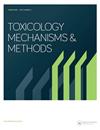邻苯二甲酸二乙酯(DEHP)对HepG2细胞脂质积累的影响及其在分子水平上的潜在机制
IF 2.7
4区 医学
Q2 TOXICOLOGY
引用次数: 54
摘要
邻苯二甲酸二乙基己酯(DEHP)被怀疑是代谢性疾病的必然因素。我们之前的研究表明,过量的DEHP可加重SD大鼠的非酒精性脂肪性肝病(NAFLD)。为了解决dehp诱导代谢功能障碍的未知领域,本研究利用HepG2细胞在体外研究了dehp诱导毒性的潜在机制。用油酸和牛血清白蛋白建立细胞脂质过载模型,然后分别暴露于不同浓度(5、10、25、50、100 μmol/l DEHP)的DEHP中进行分析。油红O染色结果显示DEHP能促进细胞内脂质积累。超氧化物歧化酶(SOD)和丙二醛(MDA)水平的变化提示氧化应激平衡被破坏。western blot分析显示,DEHP可促进过氧化物酶体增殖物激活受体α (PPARα)和甾醇调节元件结合蛋白1c (SREBP-1c)的表达。通过量化这两种蛋白的表达,我们有兴趣确定DEHP可能通过激活SREBP-1c和ppar α-信号通路来促进肝细胞的脂质积累。本文章由计算机程序翻译,如有差异,请以英文原文为准。
The effects of di 2-ethyl hexyl phthalate (DEHP) on cellular lipid accumulation in HepG2 cells and its potential mechanisms in the molecular level
Abstract Diethylhexyl phthalate (DEHP) is suspected to be an inevitable factor related to metabolic disease. Our previous study demonstrated that excess DEHP could exacerbate non-alcoholic fatty liver disease (NAFLD) in SD rats. Addressing the terra incognita in DEHP-induced metabolic dysfunction, this study used HepG2 cells to investigate the potential mechanisms involved in DEHP-induced toxicity in vitro. The cells were established lipid overload model with oleic acid and BSA, then exposed to different concentrations (5, 10, 25, 50, 100 μmol/l DEHP) of DEHP for further analysis. The Oil Red O staining results showed that DEHP could promote lipid accumulation in cells. The level of superoxide dismutase (SOD) and malondialdehyde (MDA) changed suggested the balance of oxidative stress was disrupted. Additionally, western blot analysis showed that DEHP could promote the expression of peroxisome proliferator-activated receptor α (PPARα) and sterol regulatory element-binding protein 1c (SREBP-1c). By quantifying the expressions of the two proteins, it is of interest to determine that DEHP could promote lipid accumulation in hepatocytes via activating the SREBP-1c and PPARα-signaling pathway.
求助全文
通过发布文献求助,成功后即可免费获取论文全文。
去求助
来源期刊

Toxicology Mechanisms and Methods
TOXICOLOGY-
自引率
3.10%
发文量
66
期刊介绍:
Toxicology Mechanisms and Methods is a peer-reviewed journal whose aim is twofold. Firstly, the journal contains original research on subjects dealing with the mechanisms by which foreign chemicals cause toxic tissue injury. Chemical substances of interest include industrial compounds, environmental pollutants, hazardous wastes, drugs, pesticides, and chemical warfare agents. The scope of the journal spans from molecular and cellular mechanisms of action to the consideration of mechanistic evidence in establishing regulatory policy.
Secondly, the journal addresses aspects of the development, validation, and application of new and existing laboratory methods, techniques, and equipment. A variety of research methods are discussed, including:
In vivo studies with standard and alternative species
In vitro studies and alternative methodologies
Molecular, biochemical, and cellular techniques
Pharmacokinetics and pharmacodynamics
Mathematical modeling and computer programs
Forensic analyses
Risk assessment
Data collection and analysis.
 求助内容:
求助内容: 应助结果提醒方式:
应助结果提醒方式:


